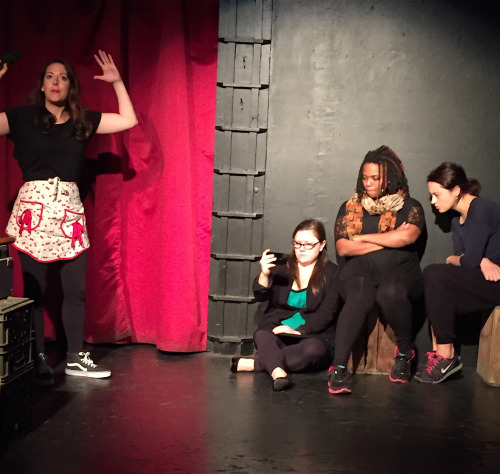
I Am Not an Allegory (these are people i know) jumps into the big questions right from the start, with a conversation between café coworkers Ames (Natalya Krimgold) and Severin (Conor Daniel Bartram) in which she puzzles over whether identity is intrinsic or constructed and what would happen if she switched lives with the people she passes when she is running, and he wonders whether there is any meaning that isn’t manufactured. Ames and Severin are two nodes in the network of characters who populate Libby Emmons's play, in which a dance class run by Danesha (Masonya Berry), forced to retreat home after a failed attempt at a professional dance career in New York City, is the hub of their intersection. Danesha is best friends with Ruby (Olivia Nice), whose feelings of emptiness are not alleviated by her relationship with Dan (Mateo D’Amato) and his concerns with power. Rounding out the class are Jess (Lindsay Perry), a single mother supporting herself with some unexpected stay-at-home work; Marcia (KL Thomas), who is afraid of accidentally revealing what she sees as her weirdness at a job interview; and Mary Ellen (Kyra Sims), who criticizes the lack of ambition shown by her boyfriend, Lando (Clifford Ray Berry), and his dreams of a music career while herself subsisting on red wine and selling jewelry.
This description is really only the barest sketch of an overview because I Am Not An Allegory is not a work easily reduced to a simple summary. There is no single, overarching plot; rather, the structure is something more like spokes on a wheel, and the play advances primarily through developing a variety of connections and relationships among the characters, as well as through the characters’ own musings. It sits somewhere between verisimilitude and pure experimentalism. It is made up of many short scenes, some between characters in a realistic mode, some that are monologues filling in backstory or inner layers of character, and others in which the character speaks with ontological awareness of being a character (Mary Ellen is seen at one point reading a Haruki Murakami novel, likely in a nod to this sort of postmodernist metafictionality). The scope of ideas is ambitious, and the scale on which they are engaged ranges from the headily abstract to the particulars of the personal.
Questions of identity and what it means to be alive thread through the production, asking who we are from the level of life choices to that of subatomic particles. These questions are often bound up with questions of desire, whether sexual, artistic or otherwise. Some ideas raised seem harder to assimilate, perhaps deliberately, into the whole, and the more abstract strains sap some urgency from the sometimes emotionally-weighted character developments. Many of the play’s best moments come when tracking the often surprising specificity of individual quirks (while of course simultaneously questioning whether any quirk can be truly individual). The cast does strong work embodying these individuals in all their particularity, with both Masonya Berry and Olivia Nice in particular delivering excellent, emotionally detailed performances in monologues near the end of the play. On the lighter side, Natalya Krimgold and Conor Daniel Bertram are great fun to watch together as Ames and the perhaps allusively-named Severin.
Performers are real people even while they are presenting themselves as fake people. I Am Not An Allegory delves into many such ideas right to the end, when it turns the tables on the audience. It offers audiences some laughs, some self-reflection, and a lot to think about. - Leah Richards & John Ziegler
